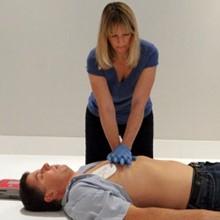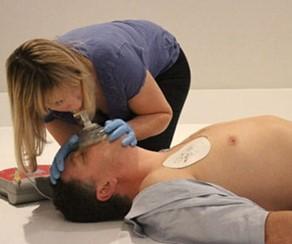Keeping Your Eyes Healthy on Your Ski Holiday
Taylor West shares their expertise and insights: Winter sports are exhilarating, but the snow, cold, and sun exposure can be harsh on our eyes. If ... Read Feature
If you are first on the scene and find someone who has collapsed or had an accident, what you do in those first minutes is critical.

Ambulance target time to get to a life-threatening emergency within eight minutes. However, in the current climate, this is just not happening and even with life-threatening emergencies you may be waiting considerably longer. The first aid you give whilst waiting for the ambulance often means the difference between life and death. At the moment the NHS is under increasing strain and the UK’s ambulance service is under more pressure than ever. The London Ambulance Service is currently receiving more than 8,000 emergency calls a day. In addition, many of their teams are stuck in A&E trying to handover patients.
To understand when someone is seriously ill or injured and when to call an ambulance, visit our article “9 signs that you should urgently call an ambulance“.
In this article we outline the vital first aid response that could help keep someone alive until the ambulance arrives.
First, take a deep breath to clear your head. Don’t rush in, keep yourself and the casualty calm and get an overview of the situation. See if you can identify what the most serious problem is. The most obvious problem isn’t always the most serious.
Ensure you and the casualty are safe from further danger and continually re-evaluate this. If you are in danger, make the situation safe (eg switch off a car engine, don’t rush out in moving traffic…) Do not move the casualty
Next, check for response. Speak to them and gently tap their shoulders or pinch them to see if they’re conscious.
Open the airway and check for breathing.
Treat the most life-threatening problems first, such as lack of breathing or catastrophic bleeding. You can check for broken bones and other injuries afterwards.
Casualty unconscious
If a person is unconscious and breathing and has no other life-threatening conditions – place in the recovery position to protect their airway.

If a person is unconscious and NOT breathing normally – start CPR. Phone an ambulance, put on speakerphone if you are on your own, and start CPR without delay.

30 chest compressions followed by 2 breaths and repeated. For a baby or child start with 5 breaths.

Find more here about how to perform CPR on a baby or child (important to give 5 breaths first).
If the person is conscious, control any bleeding with direct pressure and perform any other essential life-saving first aid as quickly as possible to stabilise their condition. Help the casualty to administer any medication if appropriate, for example GTN spray, asthma pump, Epipen etc. prior to calling an ambulance. Keep them warm and dry. Stay calm and be as reassuring as possible.
If the casualty is struggling to breathe, the best position for them to be in is sitting in an upright position. If they are in danger of collapse, you should help them to sit on the floor.
Try and establish why they are having difficulty and if they have any medication to help – are they asthmatic? Could they be having an acute allergic reaction? If so help them administer their medication straight away.
If their condition worsens, phone the ambulance service again and update them.
If they are showing signs of a heart attack sit them down in an upright position, preferably a lazy W. Encourage them to take their GTN spray if they have one. If they do not feel better and have been prescribed a 300mg Aspirin they should chew this. Phone the emergency services and stress that it is urgent. If they become unconscious and stop breathing, start CPR and if possible, get someone to bring the defibrillator quickly. Get someone to update the ambulance service that your casualty has deteriorated and is now an even higher priority.
If someone is showing signs of a stroke, they need to get to a stroke unit as quickly as possible. If the ambulance is delayed and you feel safe transporting them, take them there yourself. It is of critical importance that they are swiftly assessed as if they have a blood clot and are treated quickly enough (within a few hours) it is possible to reverse the damage. Continue to reassure the casualty and keep them warm and dry.
If they are conscious and you are concerned that they may have damaged their spine, get them to stay still and explain how important it is that they avoid twisting their back or neck. You can help them to remain still by lying behind their head, supporting the head and neck with your hands in the neutral position. If they are unconscious and breathing, (even if you are worried about their spine), if you are concerned about their airway, you should try and get help to very carefully log roll them into the recovery position, protecting their neck and back to avoid twisting.
It is strongly advised that you attend a fully regulated Practical or Online First Aid course to understand what to do in a medical emergency. Please visit firstaidforlife.org.uk or call 0208 675 4036 for more information about our courses.
First Aid for Life is a multi-award-winning, fully regulated first aid training provider. Our highly experienced medical, health and emergency services professional trainers tailor the training to your needs. Courses for groups or individuals at our venue or yours.
First Aid for life provides this information only for guidance. It is not in any way a substitute for medical advice. First Aid for Life is not responsible or liable for any diagnosis made, or actions taken based on this information.
Written by Emma Hammett for First Aid for Life

Taylor West shares their expertise and insights: Winter sports are exhilarating, but the snow, cold, and sun exposure can be harsh on our eyes. If ... Read Feature
We all know that when trying to learn a new skill consistency is key! Swimming is no exception! Our lessons run year round, with Crash ... Read Feature
Work and Play Scrapstore (WaPS) – the arts and crafts re-use charity – reported a record year for the charity at its Annual General Meeting on Tuesday ... Read Feature